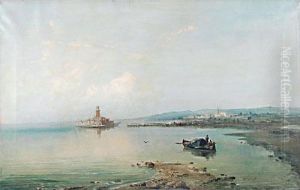Ruggero Berlam Paintings
Ruggero Berlam was an Italian architect and engineer, renowned for his significant contributions to the urban landscape of Trieste, Italy, at the turn of the 20th century. Born on August 24, 1854, in Trieste, which was then part of the Austro-Hungarian Empire, Berlam grew up in a city that was a vibrant cultural and commercial hub. His father, Giovanni Berlam, was also an accomplished architect, which provided Ruggero with an early exposure to the world of architecture and design. Ruggero pursued his education in architecture at the Academy of Fine Arts in Vienna, a center for architectural innovation and learning at the time. Upon completing his studies, he returned to Trieste, where he embarked on a prolific career that would leave a lasting mark on the city's architectural heritage.
Berlam's work is characterized by a diverse range of styles, reflecting the eclectic tastes of the era and the cosmopolitan nature of Trieste. He was adept at integrating elements of Neo-Classicism, Art Nouveau (Stile Liberty in Italy), and Eclecticism into his designs, creating structures that were both functional and aesthetically appealing. Among his most famous works is the Stock Exchange Building (Palazzo della Borsa) in Trieste, completed in 1904, which showcases his mastery of Neo-Renaissance architecture. Another notable project is the Hydrodynamic Power Station (Centrale Idrodinamica), finished in 1899, which is considered an engineering marvel of its time and reflects Berlam's ability to blend architectural beauty with industrial functionality.
Throughout his career, Berlam also contributed to the design and renovation of numerous other buildings and public spaces in Trieste, including residential buildings, villas, and schools. His works often featured innovative use of space, attention to detail, and a keen sense of aesthetics, which have earned him a place among the most respected architects in Italian history.
Ruggero Berlam's legacy extends beyond his architectural creations. He played a pivotal role in shaping the urban landscape of Trieste, contributing to its development as a modern city. His vision and designs reflect the cultural dynamism and diversity of Trieste, making him a key figure in its architectural history. Berlam passed away on November 23, 1920, but his contributions continue to be celebrated and studied as vital components of Italy's architectural heritage.
